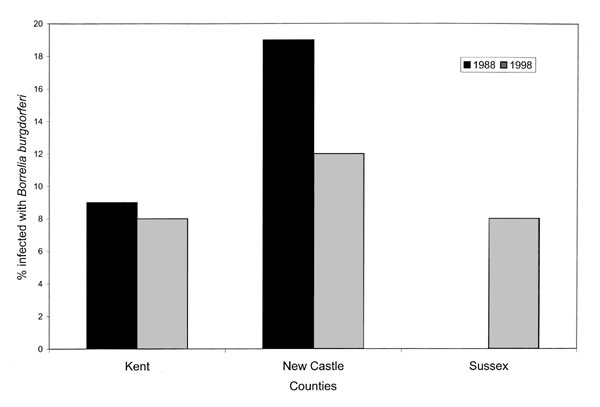Volume 6, Number 4—August 2000
Dispatch
Borrelia burgdorferi and the Causative Agent of Human Granulocytic Ehrlichiosis in Deer Ticks, Delaware
Figure 2

Figure 2. Borrelia burgdorferi infection rates in Ixodes scapularis parasitizing white-tailed deer in Delaware, 1988 (2) and 1998.
References
- Centers For Disease Control and Prevention. Lyme disease: epidemiology. 1999. [cited 1999 Dec 1] Available from URL: http://www.cdc.gov/ncidod/dvbid/lymeepi.htm.
- Pancholi P, Kolbert CP, Mitchell PD, Reed KD, Dumler JS, Bakken JS, Ixodes dammini as a potential vector of human granulocytic ehrlichiosis. J Infect Dis. 1995;172:1007–12.PubMedGoogle Scholar
- McQuiston JH, Paddock CD, Holman RC, Childs JE. The human ehrlichioses in the United States. Emerg Infect Dis. 1999;5:635–42. DOIPubMedGoogle Scholar
- Persing DH, Telford SR, Spielman A, Barthold SW. Detection of Borrelia burgdorferi infection in Ixodes dammini ticks with the polymerase chain reaction. J Clin Microbiol. 1990;28:566.PubMedGoogle Scholar
- Magnarelli LA, Stafford KC, Mather TN, Yeh MT, Horn KD, Dumler JS, Hemocytic Rickettsia-like organisms in ticks: serologic reactivity with antisera to ehrlichiae and detection of DNA of agent of human granulocytic ehrlichiosis by PCR. J Clin Microbiol. 1995;33:2710–4.PubMedGoogle Scholar
- Wolfe D, Fries C, Reynolds K, Hathcock L. The epidemiology of Lyme disease in Delaware 1989-1992. Del Med J. 1994;66:603–13.PubMedGoogle Scholar
- Walpole RE, Myers RH. Probability and statistics for engineers and scientists. 2nd edition. New York: Macmillan Publishing Co., Inc. 1978.
- Schwartz IS, Varde S, Nadelman RB, Wormser GP, Fish D. Inhibition of efficient polymerase chain reaction amplification of Borrelia burgdorferi DNA in blood fed ticks. Am J Trop Med Hyg. 1997;56:339–42.PubMedGoogle Scholar
- Persing DH, Telford SR, Rys PN, Dodge DE, White TJ, Malawista SE, Detection of Borrelia burgdorferi DNA in museum specimens of Ixodes dammini ticks. Science. 1990;249:1420. DOIPubMedGoogle Scholar
- Massung RF, Slater K, Owens JH, Nicholson WI, Mather TN, Solberg VB, Nested PCR assay for detection of granulocytic Ehrlichia. J Clin Microbiol. 1998;36:1090.PubMedGoogle Scholar
- Luckhart S, Mullen GR, Wright JC. Etiological agent of Lyme disease, Borrelia burgdorferi, detected in ticks (Acari:Ixodidae) collected at a focus in Alabama. J Med Entomol. 1991;28:652–7.PubMedGoogle Scholar
- Centers for Disease Control and Prevention. Lyme disease--United States, 1996. MMWR Morb Mortal Wkly Rep. 1997;46:531–5.PubMedGoogle Scholar
- Centers for Disease Control and Prevention. Statewide surveillance for ehrlichiosis--Connecticut and New York, 1994-1997. MMWR Morb Mortal Wkly Rep. 1998;47:476–80.PubMedGoogle Scholar
- Varde S, Beckley J, Schwartz I. Prevalence of tick-borne pathogens in Ixodes scapularis in a rural New Jersey county. Emerg Infect Dis. 1998;4:97–9. DOIPubMedGoogle Scholar
- Daniels TJ, Boccia TM, Varde S, Marcus J, Le J, Bucher DJ, Geographic risk for Lyme disease and human granulocytic ehrlichiosis in southern New York state. Appl Environ Microbiol. 1998;64:4663–9.PubMedGoogle Scholar
- Nadelman RB, Horowitz HW, Hsieh TC, Wu JM, Aguero-Rosenfeld ME, Schwartz I, . Simultaneous human granulocytic ehrlichiosis and Lyme borreliosis. N Engl J Med. 1997;337:27–30. DOIPubMedGoogle Scholar
- Centers for Disease Control and Prevention. Lyme disease--United States, 1987-1988. MMWR Morb Mortal Wkly Rep. 1989;38:668–72.PubMedGoogle Scholar
- Falco RC, McKenna DF, Daniels TJ, Nadelman RB, Nowakowski J, Fish D, Temporal relation between Ixodes scapularis abundance and risk for Lyme disease associated with Erythema migrans. Am J Epidemiol. 1999;149:771–6.PubMedGoogle Scholar
Page created: December 16, 2010
Page updated: December 16, 2010
Page reviewed: December 16, 2010
The conclusions, findings, and opinions expressed by authors contributing to this journal do not necessarily reflect the official position of the U.S. Department of Health and Human Services, the Public Health Service, the Centers for Disease Control and Prevention, or the authors' affiliated institutions. Use of trade names is for identification only and does not imply endorsement by any of the groups named above.